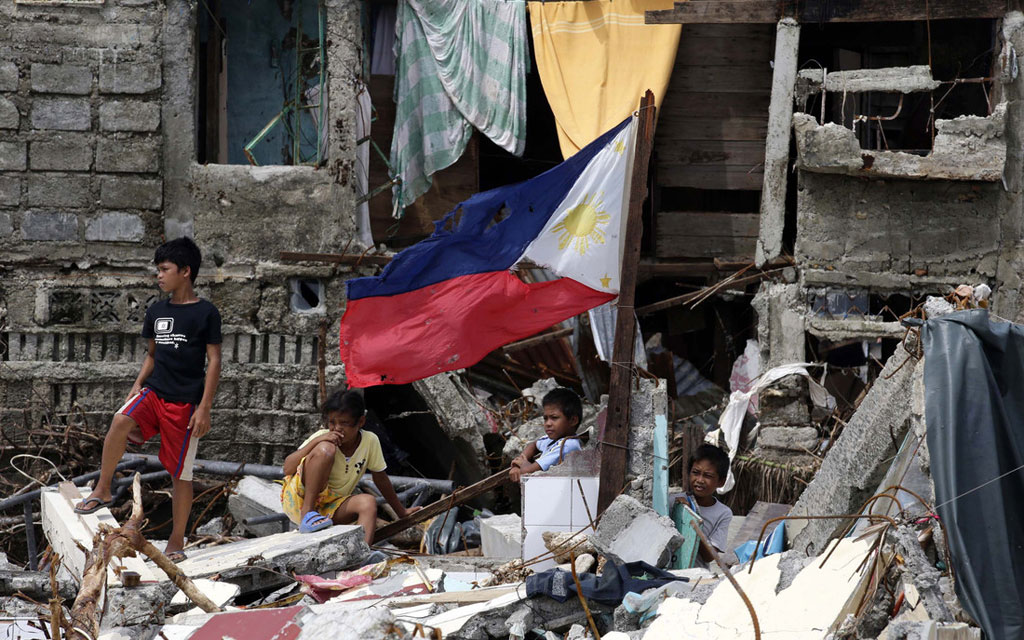Oxfam typhoon response to reach 500,000 people
 Children stand in the rubble of houses in Hernani, eastern Samar province in the Philippines. Photo by EPA/Dennis M. Sabangan.
Children stand in the rubble of houses in Hernani, eastern Samar province in the Philippines. Photo by EPA/Dennis M. Sabangan.
Oxfam has deployed rapid assessment teams to Samar, Leyte and northern Cebu to provide emergency supplies of water, sanitation, and shelter to survivors of typhoon Haiyan (or Yolanda as they are calling the storm in the Philippines).
Our colleagues in England report that a shipment of emergency materials is flying out in the next day to the Philippines.
Oxfam’s Deputy Humanitarian Director, Graham Mackay, said: “This is one of the worst natural disasters in years to hit the region and it will be a race against time to get help to the communities that have been devastated. Our main concern is getting relief to the worst affected areas.
“Because communications are down the real extent of this horrific disaster is still not known.”
Current estimates are that 9.68 million people – approximately 2 million families – from 41 provinces have been affected.
Oxfam is collaborating with UN agencies and other aid organizations to assist survivors in eastern Visayas, from Borongan to Tacloban. The initial response will concentrate on clean water, food, and shelter. In emergencies like this, providing clean water and sanitation helps avoid outbreaks of water-borne diseases that can kill many more than the initial disaster.
At this point Oxfam intends to assist a half million storm survivors. Anyone reading this can contribute to this effort by donating to the Typhoon Haiyan Relief and Recovery Fund.
Witness to disaster
Golda Hilario, a member of Oxfam’s rapid assessment team on the ground in Tacloban city (in one of the hardest hit provinces, Leyte) reports that “100 per cent of the city is devastated. Pharmacies are being looted and there’s real need for basic medicines like antibiotics and medical equipment like surgical gloves. Food markets are closed and lootings have been reported because of the dire lack of food. There is no running water and no electricity. People are taking desperate measures, like trying to puncture water pipes, to get water.”
One mother with two small children, who works selling fish with her fisherman husband, told Oxfam it was like a tsunami when the storm hit:
“Many storms have passed here. But we did not expect a storm that brought a ‘tsunami’ with it. We only know of rain and wind. We did not expect the sea would devour the land.”
She has received a food pack containing three kilos of rice, sardines and corned beef. She expects to use this up within two days.
“We have nothing to go back to. We can’t fish. It’s dark and there are dead bodies floating in the sea.”
Worst effects of storm miss Vietnam
Our colleagues in Vietnam are telling us that typhoon Haiyan’s track shifted north as it crossed the South China Sea, parallel to the Vietnamese coastline. “The storm made landfall in the northern provinces of Hai Phong and Quang Ninh, and had weakened to a category 1 typhoon…
We have not heard of any direct casualties from the storm.”
Averting a severe disaster in Vietnam will help free up resources for the Philippines – we still don’t know the real extent of the disaster there, but it’s clear that the response will be need to be massive.
Donate to the Typhoon Haiyan Relief and Recovery Fund:
Oxfam teams are ready to deploy water and sanitation materials to those affected. We urgently need your help to scale up our response.